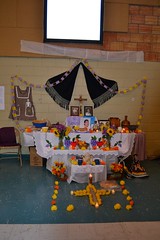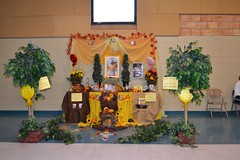 Nathan Crites-Herren
Nathan Crites-Herren
The Paw Print
For many in the United States, the celebration of Día De Los Muertos (Day of the Dead) is merely a continuation of Halloween created by Mexican and other Latin American peoples. However, the actual significance differs from Halloween which historically was celebrated by Celtic peoples to mark the end of summer. Instead Dia De Los Muertos, celebrates life by focusing on its’ opposite, death.
The roots of this celebration come from the rich history of indigenous peoples who populated Central America throughout the areas of present day Mexico, Guatemala and Ecuador. During and after the bloody conquest of these areas in Central America, the Spaniards began to assimilate the local population.
A principal tool in that assimilation was the Catholic Church, which worked to convert millions of indigenious peoples. Despite the loss of many religious traditions that natives practiced, they managed to integrate many religious traditions into their newly appointed Catholic faith, one of those being what we know today as Día De Los Muertos.
Adams States’ El Parnaso Spanish Club continues this long standing tradition with its annual community wide Día De Los Muertos celebration, which took place on November 2 at the Sacred Heart Catholic Church in Alamosa. Through their annual event, El Parnso seeks to bring the understanding of Día De Los Muertos to the entire community in an engaging and hands on manner which embraces the entire family. “Not only is this a cultural service for the many Latino families who have grown up celebrating Dia De Los Muertos in their country, but it also serves to inform the entire community about the holiday and it’s rich traditions,” said El Parnasos’ advisor and Assistant Professor of Spanish, Dr. Eva E. Rayas-Solis.
Provided familial activities included the traditional decoration of sugar skulls, paper flower origami and color

ing of the popular catrina skeleton which is traditionally outfitted with an elegant black or red dress. The intention behind the sugar skulls, paper flowers and the catrina is to create relics that represent the passes of life through death. Once finalized, these relics are traditionally placed on the altars that honor the dead, which are at the heart of the celebration. “The altars are a celebratory message to those who have passed on that they have not been forgotten,” said Rayas-Solis.
Participation from children was also a central component of this year’s event. According to Rayas-Solis, El Parnaso’s goal in creating this event was principally to generate a space in which children could understand and enjoy its significance. The activities associated with Día De Los Muertos help teach children to embrace the unknown by de-mystifying accepted concepts of death. This is seen in the principal images of animated skeletons and skulls that exemplify the duality between death and life.
Members of El Parnaso drew from various resources to make this year’s celebration unique. Taking a research trip to the Longmont Community Center, that traditionally hosts one of the largest Día De Los Muertos celebrations in the state, club member were able to expand their knowledge of the event and transfer that understanding to their November 2 event. “Thanks to the things we learned from the Longmont event, we were able expand the horizons of our event and hope to expand further in the coming years,” said Rayas-Solis.
**Photos by Nathan Crites-Herren: Pictures of Dia De Los Muertos
What’s Been Said…